Mars: A Planetary Star
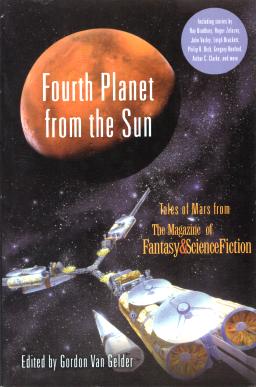 John O’Neill’s August 5th blog article, “All Eyes on Mars as Curiosity Prepares to Land,” focused on the suspense of waiting for the rover to land safely on Mars. The two-thousand pound (900 kg) rolling geology lab did in fact make a flawless landing on August 6th and with its touchdown, it revived interest in the Red Planet. From the description of Curiosity given on Jet Propulsion Lab’s website, the rover truly belongs in a science fiction tale.
John O’Neill’s August 5th blog article, “All Eyes on Mars as Curiosity Prepares to Land,” focused on the suspense of waiting for the rover to land safely on Mars. The two-thousand pound (900 kg) rolling geology lab did in fact make a flawless landing on August 6th and with its touchdown, it revived interest in the Red Planet. From the description of Curiosity given on Jet Propulsion Lab’s website, the rover truly belongs in a science fiction tale.
- body: a structure that protects the rover’s “vital organs”
- brains: computers to process information
- temperature controls: internal heaters, a layer of insulation, and more
- “neck and head”: a mast for the cameras to give the rover a human-scale view
- eyes and other “senses”: cameras and instruments that give the rover information about its environment
- arm and “hand”: a way to extend its reach and collect rock samples for study
- wheels and “legs”: parts for mobility
- energy: batteries and power
- communications: antennas for “speaking” and “listening”
The size of a small SUV, the rover has already begun its mission to “search areas of Mars for past or present conditions favorable for life, and conditions capable of preserving a record of life.” It is equipped to gather data, take photographs and then send the information back to JPL. In other words, Curiosity is our roving reporter on Mars. Kind of gives a whole new concept to being a “foreign” correspondent, doesn’t it?
With Curiosity running around on Mars, what better time is there to combine science with fiction and review some of the stories written about the Red Planet? A good start is Gordon Van Gelder’s anthology, Fourth Planet From The Sun. It was published by Thunder’s Mouth Press in 2005, about a year after the Mars rovers Spirit and Opportunity started to send back their photos of Mars. It is fitting that with the successful landing of Curiosity, we take another look at it.
Gordon Van Gelder made some excellent choices to celebrate a planet that has captured earth’s interest for millennia. The stories here, all originally published in The Magazine of Fantasy and Science Fiction, range not only in subject matter, but across time itself. From Ray Bradbury’s “The Wilderness,” which was written in 1952, to Alex Irvine’s “Pictures From an Expedition,” which was published in 2003. As Van Gelder says in his introduction: “the time seems right to collect these various stories and let you see for yourself how our perceptions and images of Mars have changed over the past fifty years.”
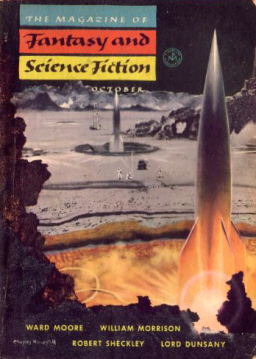
Van Gelder begins with Ray Bradbury’s “The Wilderness,” which is basically an intergalactic story of mail order brides. What’s most interesting is what Bradbury envisions for us fifty years into the future. Although the story was written in 1952, it takes place in our present past of 2003. Two women are preparing to travel over 60,000,000 miles to Mars to a town built by the men who are waiting for them. The night before their spacecraft leaves for another world, one of the women spends a sleepless night. “Is this how it was over a century ago, she wondered, when the women, the night before, lay ready for sleep, or not ready, in the small towns of the East and heard the sound of horses in the night and the creak of the Conestoga wagons ready to go…”
What to take? What must be left behind? Those same questions must be answered by anyone who is leaving behind a familiar culture and even civilization itself.
“Mars is Ours” by Alfred Coppel contrasts sharply with the homespun Mars portrayed by Bradbury. Here America is still at war with the Russians. A war that has spilled over onto Mars, where the USA has prevailed. Written in 1954, it is the story of a task force of soldiers who have been traveling through the thin Martian atmosphere in their armored vehicles for almost a year. Their supplies are low and they are looking forward to getting back to the main base, now only eight-hundred miles away. Like all soldiers, they dream of home — only in this case, it’s a small dot in the sky—a world that contrasts sharply with the red sand dunes they have crossed for many months. The Cold War is still being fought on Earth, but “winning” becomes a different concept on Mars.
As editor Van Gelder points out, “Crime on Mars,” written in 1960 by Arthur C. Clarke, is one of the first stories to depict exploration on Mars more realistically. As the story unfolds, the reader discovers that every city on Mars is a “closed little world of its own beneath the force field that protects it from the freezing near-vacuum. Beyond those electronic shields is the utterly hostile emptiness of the Martian Outback, where a man will die in seconds without protection.”
Although Detective-Inspector Rawlings remarks in the opening line, “We don’t have much crime on Mars,” there has been a major theft from Meridian City’s Museum. Mars’s greatest treasure, the Siren Goddess, has been stolen. The museum piece is an enigma “so baffling that it has inspired a hundred religious sects, and driven quite a few archaeologists out of their minds. For a perfectly human head has no right whatsoever to be found on Mars, whose only intelligent inhabitants were crustaceans…” To retrieve this invaluable piece of history, capture the thief and discover the fence who received it, Detective-Inspector Rawlings turns to Time itself.
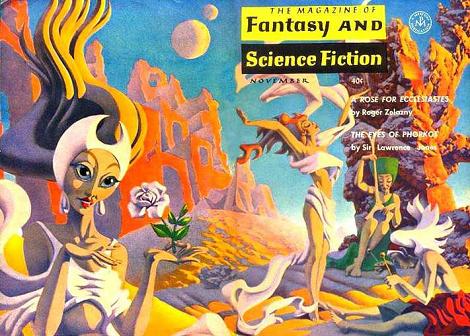
In Leigh Brackett’s “Purple Priestess of the Mad Moon,” [1964] Harvey Selden has come to Mars to re-educate the Martian people in their ancient skills of metal craft. But before he can even start to teach, he is kidnapped and taken to the forbidden Low Canal towns. As the ancient Rites involving the Denderon moon, human sacrifice, and the worship of a Dark Lord are revealed to him, he also learns about terror.
“A Rose for Ecclesiastes” by Roger Zelazny [1963] is a well-crafted story with sharply-defined characters. This time the visitor to Mars is a writer with a talent for languages. He receives an invitation from the Martian Matriarchy to view ancient documents at a monastery that few Earthmen are allowed to enter. It is a rare opportunity to receive advance lessons in their language and culture. When he is invited to view the Dance of Locar, the highest art form on Mars, he falls in love with the dancer and is told of a secret pact. As in “Purple Priestess,” there are always consequences to acquiring hidden information.
“We Can Remember It For You Wholesale” is the Philip K. Dick story made into the movie Total Recall. The twists and turns remind me of the Russian matryoshka or nesting dolls. Ultimately, it isn’t so much a question of who he really is as who he thinks he really is and it’s a story where perception is everything.
In Gordon Eklund and Gregory Benford’s “Hellas Is Florida,” life on Mars has been confirmed by the two-decade succession of robot probes, both American and Russian in origin. When life is discovered, an American manned exploration group is sent to investigate. Their mission is to determine its source and why it exists. The title comes from the statement: “On Earth, there’s more life in Florida than in Greenland. It’s easier to stay alive in Florida. Hellas might be the Florida of Mars.”
“Hellas Is Florida,” which was published in 1977, was written two years after the first Viking orbit and landing. The authors did their homework. Astronauts wear space suits and encounter deadly dangers while exploring. Moreover, the location names are also accurate.
McIntyre had loudly asserted that it was ridiculous to send a manned expedition to Mars and ignore the volcanic constructs and plains; he favored a landing site somewhere on the volcanic plain between Tharsis Ride and Olympus Mons. NASA rejected the suggestion. Life-forms, not rocks had motivated the $20 billion investment and life-forms happened to be most plentiful in the southern Hellas region.
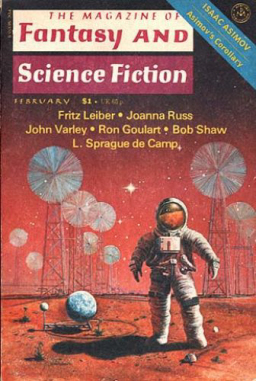
In 1977, the authors were right about the importance NASA places on finding life-forms on Mars. Their subsequent missions, including those of the Mars rovers, agree with the goals outlined in the story. Spirit and Opportunity were launched in 2003 (Opportunity is still operating). Their mission is to search for answers regarding the history of water on Mars. Curiosity, which landed on August 6, 2012, was designed to assess whether Mars ever had an environment able to support small life forms called microbes.
The accuracy of the authors, regarding the search for life-forms, raises the question: Are their predictions regarding the unforeseen consequences also correct?
“In the Hall of the Martian Kings” by John Varley again offers another realistic view of life on Mars, starting with names of actual locations on the planet. It’s a fascinating and compelling story of an expedition that becomes a colony after a disaster strikes, killing several of their group, including the only person qualified to pilot their shuttle back to the mother ship. Marooned on Mars, the story lies not in how they adapt to their environment, but how the Red Planet adapts to them.
Written in 1979, the science in Robert F. Young’s “The First Mars Mission” is very low tech. but it doesn’t fail to capture the reader’s imagination from the very first pages.
They had built the spaceship in Larry’s backyard. His backyard was bigger than either Chan’s or Al’s. This was because his parents’ house was on the outskirts of town where the houses were far apart and did not belong to blocks, where in some cases the whole countryside stretched away from your back door…
For landing jacks they used a pair of old sawhorses Al found in the loft of his father’s garage. Upon them they nailed the deck — a platform constructed of scrap lumber they swiped from behind the new school building. Chan’s father, who was a junk dealer, had already told them they could borrow the big conical vented tin smokestack he’d “collected” when the Larrimore grain-machinery factory was torn down, and one simmering July afternoon they freed it from the debris in the rear of the fenced-in junkyard and rolled it all the way across town to Larry’s house. There, panting and perspiring, they jockeyed it onto the deck and braced it with three toenailed two-by-fours.
Scraping and painting the stack took them two days. It didn’t cost them anything though, because there were all kinds of paint cans in Larry’s basement, with varying quantities of paint still in them. No two of the colors were the same, but by mixing the brightest ones together they came up with a beautiful greenish blue.
On the third day, after the paint had dried sufficiently, they installed the ion-drive — a 3-HP Briggs & Stratton motor Al’s father had saved when he got rid of his old power mower. They’d already sawed out a 2’ x 2’ section of the deck and constructed a lock that functioned on the same principle as a trapdoor. Lastly they installed the control panel — a 1957 Ford dash donated by Chan’s father.
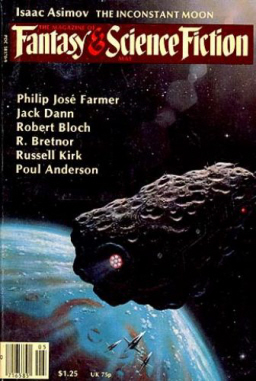
Once their spacecraft was built, they turned to other launch details:
…they scheduled liftoff for 2200 hours the following night. Mars should be visible at that hour enabling them to set their course. Since the round trip would probably take at least two hours and they wanted plenty of time to explore, they had to get their parents’ permission to stay out all night. Chan and Al had no trouble on this score, but Larry’s mother had a fit, and only the intervention of his father had made his participation in the historic Marsflight possible.
They spent the next day loading equipment and supplies on board, painting The Martian Queen in big black letters on the ship’s prow, and speculating on what they would find when they reached their destination. The equipment consisted of three sleeping bags and Larry’s father’s flashlight. The supplies comprised three ham-salad sandwiches (courtesy of Chan’s mother), three eight-ounce cans of Campbell’s Pork and Beans (lifted by Larry from his mother’s kitchen cupboard,) and three cartons of chocolate milk.
For weapons, the boys took along a baseball bat, a hatchet, and a Boy Scout knife that had four blades and would also open the pork and beans. Then, with everything on board the spacecraft:
Larry switched on the flashlight, shone the beam on the control panel and set their course. Al began the countdown. When he reached zero, Larry activated the ion-drive. ‘We’re on our way!’ he shouted.
Their adventure and its aftermath make this an unusual and fun story.
“The Last Mars Trip,” written by Michael Cassutt in 1992, has two story lines. The first begins:
She had not had bread in five days, and even then it had been stale. Well, all of it was now. Since the death of her mate, there had been no one left to plant bread, no one left to nurture it, no one — she believed — left to eat it.
It is also a story about the first humans on Mars, explorers who are concerned that their ratings are conflicting with the war at the South Pole. When one of the group accidentally discovers indigenous life, he describes it as “(a) lump the size of a small dog covered in the same fabric as the sample in his pocket. A lump with at least three arms that he could see. A lump that was visibly crouching away from him.”

He discloses this discovery only to his friend, knowing if this expedition confirms life, the Red Planet will be crawling with humanity in five years. And with them will come the wars and problems from Earth. How the Martian life-form survives, the fate of her three offspring, as well as that of the future of Mars made this one of my favorite tales.
“The Great Martian Pyramid Hoax” [1995] by Jerry Oltion. To give too many details about this story would spoil the ending. Basically, it is the tale of a Mars expedition that is launched as the result of a photo taken on July 25, 1976 by the Viking probe.
“The Face” made headlines in the tabloid newspapers and in order to explore the possibilities of intelligent life on Mars, two astronauts are sent. They know this mission could make or break the space program.
So far they hadn’t discovered anything useful in selling Mars to the taxpaying public, and that was the real catastrophe. As Al Shepard had once said about the Mercury program, “No bucks, no Buck Rogers.” You had to have public support if you wanted money enough to fly…
As a last resort, the two astronauts decide to film “The Face” up close. The hoax begins to evolve when they land to investigate a cave entrance at its base.
The last story in Fourth Planet From The Sun, “Pictures From an Expedition” by Alexander C. Irvine, was first published in 2003 and provides yet another description of a first flight to Mars. In Irvine’s version, these interplanetary excursions are underwritten and sponsored by commercial companies.
The first trip is named after HotVegas, a corporation that promotes betting large amounts of money on such subjects as: whether violence will break out among the crew (1 to 3 odds); whether a crew member will be murdered (12 to 1); and whether all six Argos crew members survive the mission (9 to 4).
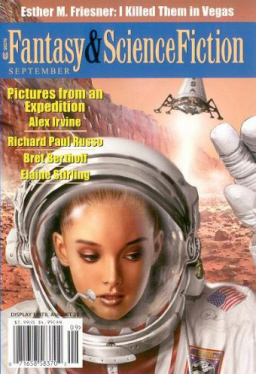
For “Pictures,” think paparazzi and reality TV, combined with a crew that is contained in a very small space for three years with an accompanying range of human emotions. The focus is on an attractive young female engineer re-named Barbarella by an adoring public whose focus has become so narrow it dismisses the monumental scientific discoveries made by the explorers.
The public’s thirst for intimate information about her and the other five members of the crew, along with betting on the most private details of their lives quickly becomes a nightmare. This is a horror story and in this case, we are the monsters.
I discovered this next story about Mars thanks to the Howard Andrew Jones’ Black Gate article: “Leigh Bracket: American Writer.” After I read his introduction to “The Last Days of Shandakor,” I decided to take up his challenge and re-discover the author he referred to as “a master writer.”
The result was Fourth Planet From The Sun, reviewed above, which contained “The Purple Priestess of the Mad Moon” and “Shandakor” which appears in The Best of Leigh Brackett (Ballantine Books, 1977).
As Howard Andrew Jones says in his blog, Brackett wrote in an era when Mars and Venus were considered habitable planets. That was then and it’s a tribute to her skill as a writer that I was able to suspend my disbelief and accept a Martian atmosphere, existing water and an indigenous population. While she created a colorful world, ultimately Leigh wrote about people and the challenges that faced them, no matter what background she gave them.
In his introduction “Story Teller of Many Worlds,” her husband, Edmond Hamilton, says:
A favorite and recurring theme of the Leigh Brackett stories — [is] the theme of a strong man’s quest for a dream and of his failure when it turns to smoke and ashes in his hands.
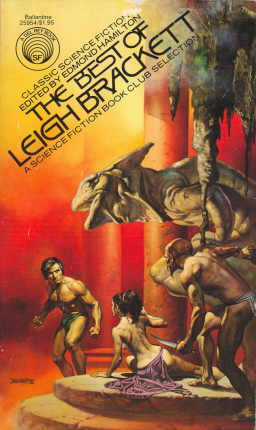 Brackett’s “The Last Days of Shandakor” is the only Mars story to appear in the anthology. After the introductory paragraphs so enticingly presented in the Howard Jones article, JonRoss becomes obsessed with the red-cloaked man:
Brackett’s “The Last Days of Shandakor” is the only Mars story to appear in the anthology. After the introductory paragraphs so enticingly presented in the Howard Jones article, JonRoss becomes obsessed with the red-cloaked man:
I was thinking, A new race, an unknown race! I was thinking of the fame that sometimes comes to men who discover a new thing, and of a Chair I might sit in at the University if I added one bright unheard-of piece of the shadowy mosaic of the Martian history. I had my share of wine and a bit more. That Chair looked a mile high and made of gold.”
But like all prizes, the winning of it isn’t always easy, nor does it come without a price. After the red-cloaked man changes his mind in the middle of the journey, JonRoss is robbed of his supplies and does not have enough water for the return trip to Barrakesh.
With no other options, he enters Shandakor, a city shunned even by those who robbed him. Again, falling in love brings unlooked for results. JonRoss follows his dream and achieves the Chair he so craves, but at a terrible price.
Another very enjoyable story about Mars comes from Isaac Asimov. “The Martian Way” was first published in the November 1952 issue of Galaxy Science Fiction and has been reprinted in several collections, including The Martian Way and Other Stories and The Best of Isaac Asimov.
The story was written in the early 50s and Asimov sees Mars as a dead planet colonized by settlers from Earth. Generations later, descendents of the original Earth colonists have been born and raised on Mars. Although they are learning to supply their own needs, the colony is still dependent on Earth for its water.
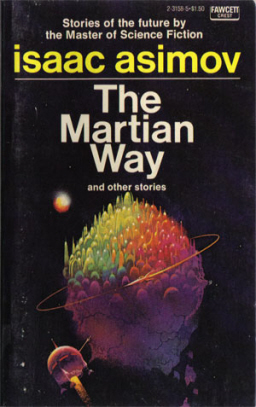 But the existence of the colony is endangered by Earth politicians who want to cut off the water supplies. In spite of the scientific studies proving almost all of the water used by the space ships for takeoff is returned to the planet as they leave Earth’s atmosphere, water shipments to Mars are drastically reduced. This has threatened the livelihood of two space scavengers, Mario Esteban Rioz and Ted Long, who collect the huge spent rocket containers when they are ejected after liftoff. Some of the colonists are in favor of stealing the water that is vitally needed to run all the equipment on Mars.
But the existence of the colony is endangered by Earth politicians who want to cut off the water supplies. In spite of the scientific studies proving almost all of the water used by the space ships for takeoff is returned to the planet as they leave Earth’s atmosphere, water shipments to Mars are drastically reduced. This has threatened the livelihood of two space scavengers, Mario Esteban Rioz and Ted Long, who collect the huge spent rocket containers when they are ejected after liftoff. Some of the colonists are in favor of stealing the water that is vitally needed to run all the equipment on Mars.
Ted Long has a different idea for solving the problem. The plan is impossible by Earth standards, but, as Long says, his method is just a matter of doing it the Martian Way.
Well, time to shake the red dust from the neural pathways and come back to Earth. As we leave our Roving Reporter on Mars to its mission, the many stories about lonely robots come to mind. Hopefully, JPL scientists are fans of science fiction and fantasy. If so, they will have warned Curiosity that interplanetary and inter-species romances on the whole, don’t work out.
Or, perhaps they have provided Curiosity with a map to locate Opportunity, which is still operating. Between the two of them, they can repair Spirit’s right front wheel and recharge its batteries. When the human explorers finally do arrive, the Three Musketeers of Mars will be waiting at the landing site to greet them.
Kudos to all the scientists and staff involved in Curiosity’s mission to Mars.
Shades of FOURTH PLANET TO THE SUN. Just have to post this link to the latest Mars story: http://news.yahoo.com/blogs/sideshow/spidery-black-objects-mars-surface-raise-speculation-184239849.html
It’s difficult to tell which FOURTH PLANET story is the closest to this latest discovery: “Hellas is Florida” or “The Hall of the Martian Kings?” Personally I might have to go with “The Great Pyramid Hoax.”
Perhaps the abilities to foretell the future and “remote viewing” are what make good science fiction writers. Somebody is going to have to go up there and investigate.
BB
[…] Mars: A Planetary Star […]
Our Roving Reporter on Mars is still at it: http://www.cnn.com/2012/08/14/tech/gallery/mars-curiosity-rover/index.html?hpt=hp_t2
The third photo in shows a self photo of Curiosity. Notice the red tinge from the Martian soil. There are several self pictures. In some, it looks as if Curiosity is waving hi to earthlings!
BB
Our foreign correspondent on Mars continues to astound. After only seven months into its two year mission, Curiosity has already determined that Mars was once habitable.
http://news.yahoo.com/finding-mars-habitable-curiosity-rover-keep-roving-191536752.html
“The rover’s observations show that Mars was indeed habitable long ago, when the planet was warmer and wetter…”
“”We would guess that if micro-organisms ever evolved on Mars, they would thrive here…”
According to JPL scientists, Curiosity’s next mission, is to “find water on Mars that has the right chemistry for micro-organisms.”
Way to go, Curiosity!
[…] also publishes digital versions of Fourth Planet from the Sun (covered here) and […]